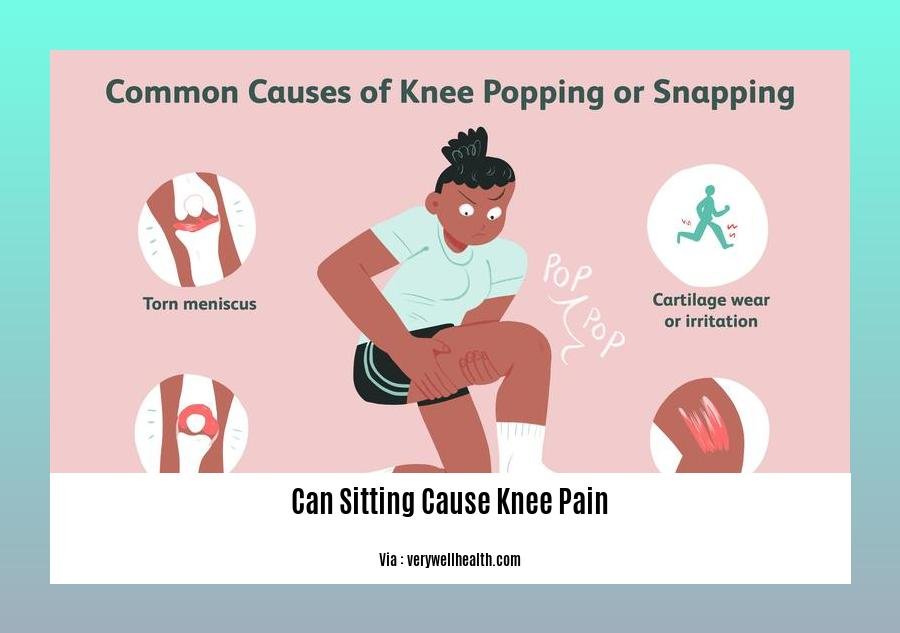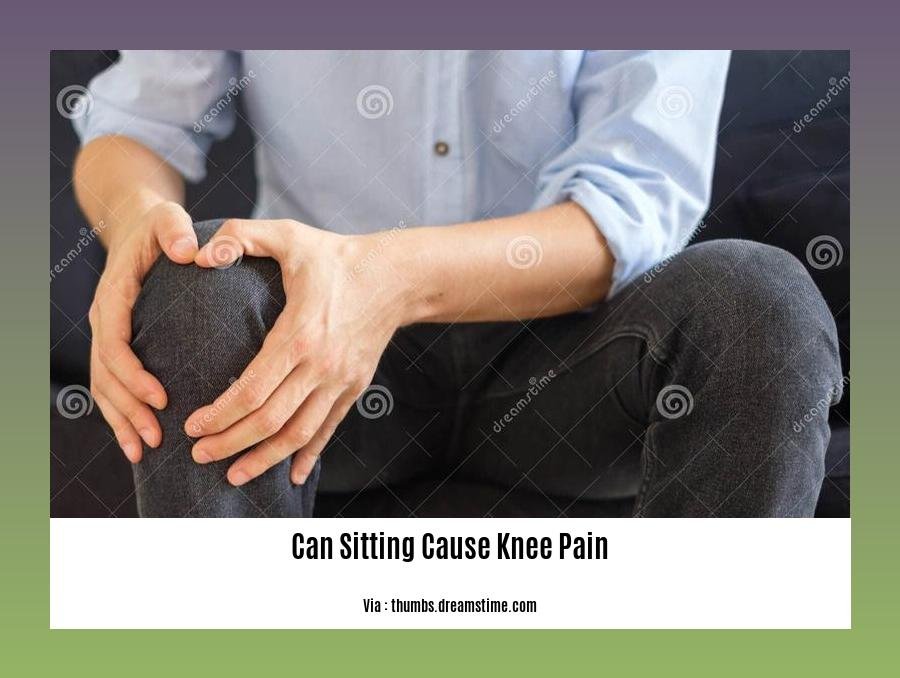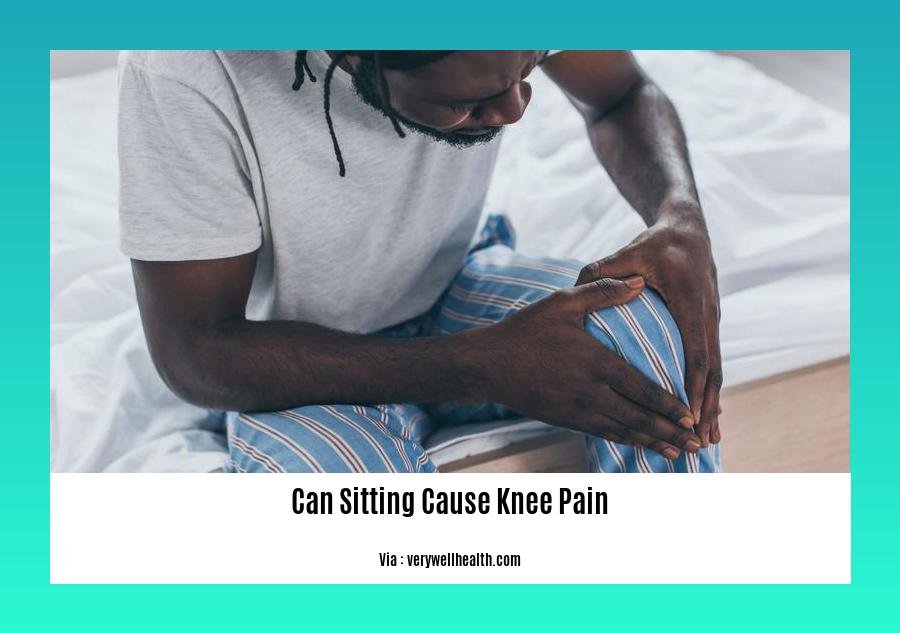[[Solved] Can Sitting Cause Knee Pain? Here’s What You Need to Know]: If you’re experiencing knee pain and spend long hours sitting, you may wonder if there’s a connection. Discover the truth behind this common concern and uncover expert insights to help you understand, prevent, and alleviate knee pain related to prolonged sitting.
Key Takeaways:
-
Knee pain can be common while sitting, transitioning between sitting and standing, and overall discomfort.
-
Factors such as arthritis, improper positioning, prolonged inactivity, and sitting in an awkward position can contribute to knee pain.
-
Taking regular mobility breaks, using proper posture, adjusting your workstation setup, and investing in an ergonomic office chair can help prevent knee pain.
-
Consult a healthcare professional if knee pain is severe or persistent as they may suggest various treatments, including physical therapy, medication, or surgery.
Can Sitting Cause Knee Pain?

Sitting for extended periods can indeed contribute to knee pain. Here are some common causes and preventive measures to consider:
Causes of Knee Pain when Sitting:
-
Posture: Poor posture, such as slouching or sitting with bent knees, can strain the knee joint and cause discomfort.
-
Improper Seating: Uncomfortable or poorly designed chairs can put pressure on the knees, leading to pain.
-
Lack of Movement: Prolonged sitting without regular movement can stiffen the knee joint and cause pain.
-
Underlying Medical Conditions: Conditions like arthritis and patellofemoral pain (runner’s knee) can worsen with prolonged sitting.
Preventing Knee Pain While Sitting:
-
Take Breaks: Get up and move around every 20-30 minutes to keep your knees active and prevent stiffness.
-
Proper Posture: Maintain good posture by sitting upright with your feet flat on the floor and your back supported.
-
Adjust Your Workstation: Ensure your chair height and desk height are set correctly to avoid slouching or straining your knees.
-
Ergonomic Chair: Invest in an ergonomic chair that provides proper support and comfort, especially if you sit for long hours.
-
Stretching: Regularly stretch your leg muscles, particularly your hamstrings and quadriceps, to maintain flexibility and reduce knee pain.
When to Seek Professional Help:
If your knee pain is severe, persistent, or accompanied by swelling, redness, or decreased mobility, consult a healthcare professional. They can evaluate the underlying cause and recommend appropriate treatment.
Remember, preventing knee pain while sitting involves maintaining good posture, taking breaks from prolonged sitting, and incorporating regular movement into your daily routine. If you experience persistent knee pain, seek professional advice to rule out any underlying medical conditions.
-
Dreaming of a beach vacation? Explore our curated collection of boutique hotels along Florida’s Gulf Coast for an unforgettable getaway.
-
Treat yourself to a delightful surprise with our exceptional candy box filled with an assortment of delectable treats—the perfect gift for any occasion.
-
Discover the intricate meaning of “bungle” in Bengali by delving into our comprehensive guide to bungle meaning.
-
Enhance your understanding of the Tamil language with our exploration of the bungle meaning, providing insights into its nuances and usage in various contexts.
Identifying Individuals at Higher Risk of Developing Sitting-Related Knee Pain

Sitting for long periods, especially with poor posture or inadequate support, can strain the knee joint and lead to discomfort. Certain factors increase an individual’s risk of developing sitting-related knee pain. Recognizing these risk factors can help you take preventive measures and seek timely intervention if necessary.
Key Takeaways:
-
Prolonged Sitting: Individuals who engage in prolonged sitting, particularly those with sedentary occupations or lifestyles, are at an elevated risk.
-
Poor Posture: Maintaining improper posture while sitting, such as slouching or crossing legs, can strain the knee joint and exacerbate pain.
-
Inadequate Chair Support: Using chairs that lack proper lumbar support or do not allow for proper positioning of the feet can contribute to knee pain.
-
Obesity or Being Overweight: Excess weight puts additional stress on the knee joints, making them more susceptible to pain and discomfort.
-
Pre-existing Knee Conditions: Individuals with a history of knee injuries, osteoarthritis, or other knee-related ailments are more likely to experience sitting-related knee pain.
-
Weak Leg Muscles: Poorly developed leg muscles, especially the quadriceps and hamstrings, can compromise knee stability and increase the risk of pain.
-
Tight Hamstrings: Tightness in the hamstring muscles can pull the knee joint out of alignment, leading to pain and discomfort.
-
Lack of Regular Physical Activity: Individuals who lead sedentary lifestyles and do not engage in regular physical activity may experience weakened muscles and reduced flexibility, making them more prone to sitting-related knee pain.
-
Certain Occupations: Occupations that require prolonged sitting or repetitive knee movements, such as construction, driving, or nursing, can increase the risk of developing sitting-related knee pain.
Preventive Strategies:
-
Take Frequent Breaks: Get up and move around every 20-30 minutes to prevent stiffness and promote blood flow to the knee joints.
-
Maintain Good Posture: Sit upright with your feet flat on the floor and your back supported by a chair with good lumbar support. Avoid slouching or crossing your legs.
-
Choose Ergonomic Chairs: Opt for chairs that offer proper lumbar support, adjustability, and allow for proper foot positioning.
-
Strengthen Leg Muscles: Engage in regular exercises to strengthen the muscles around the knee, such as squats, leg extensions, and hamstring curls.
-
Stretch Regularly: Regularly stretch your hamstrings, quadriceps, and calf muscles to maintain flexibility and reduce muscle tightness.
-
Manage Weight: If you are overweight or obese, consider implementing lifestyle changes to lose weight and reduce the load on your knee joints.
-
Consider a Standing Desk: If possible, incorporate a standing desk into your workspace to reduce prolonged sitting and promote movement throughout the day.
Remember, if you experience persistent or severe knee pain, it’s essential to consult a healthcare professional for proper diagnosis and treatment.
Citations:
WebMD: Knee Pain From Sitting Too Long?
Mayo Clinic: Knee Pain
Strategies to Prevent and Manage Knee Pain Caused by Sitting
“8 hours a day, 5 days a week. That’s a lot of sitting. And if you’re not careful, it can really do a number on your knees.”
Sitting for long periods puts a lot of pressure on your knees. This can lead to pain, stiffness, and even arthritis. But don’t worry, there are things you can do to prevent and manage knee pain caused by sitting.
How Sitting Can Cause Knee Pain
When you sit, your knees are bent at a 90-degree angle. This puts pressure on the cartilage in your knees, which can cause it to break down over time. This can lead to pain, stiffness, and swelling.
How to Prevent Knee Pain While Sitting
Sitting up straight with your feet flat on the floor will help take the pressure off of your knees. You can also use a footrest to keep your feet elevated.
Avoid crossing your legs for long periods of time. This can put excessive pressure on your knee joints.
Get up and move around every 20-30 minutes. Even a short walk or stretch can help to keep your knees healthy.
Make sure your chair is the right height for you. Your feet should be flat on the floor and your thighs should be parallel to the ground.
Use a chair with good lumbar support. This will help to keep your back straight and reduce the pressure on your knees.
Use a knee pillow or cushion to support your knees while sitting. This can help to reduce pain and swelling.
How to Manage Knee Pain While Sitting
If you already have knee pain, there are things you can do to manage it while sitting.
Take over-the-counter pain relievers. Acetaminophen, ibuprofen, and naproxen sodium can all help to relieve knee pain.
Apply ice or heat to your knees. Ice can help to reduce inflammation and pain, while heat can help to relax the muscles around your knees.
Use a knee brace or support. This can help to stabilize your knee and reduce pain.
Do knee exercises. There are a number of exercises that can help to strengthen the muscles around your knees and improve your flexibility.
See a doctor if your knee pain is severe. If your knee pain is severe or doesn’t improve with home treatment, see a doctor. They may recommend physical therapy, injections, or surgery.
Key Takeaways:
- Sitting for long periods can increase your risk of developing knee pain.
- To prevent knee pain while sitting, maintain good posture, take frequent breaks, and adjust your chair for proper support.
- If you already have knee pain, manage it by taking over-the-counter pain relievers, applying ice or heat, using a knee brace or support, and doing knee exercises.
- If your knee pain is severe or doesn’t improve with home treatment, see a healthcare professional.
Relevant URL Sources:
- How to Sit To Avoid Knee Pain? – Brandon Orthopedics
- What Helps Knee Pain from Sitting All Day? – MedicineNet
Seeking Medical Attention When Necessary
If you’re experiencing sharp knee pain when sitting, it’s crucial to know when to seek professional help. While some knee pain may be manageable with self-care measures, others may require medical attention. Here are some signs that indicate the need for professional evaluation:
-
Persistent Pain: If your knee pain persists for more than a few weeks or worsens over time, it’s best to consult a healthcare provider. Persistent pain can indicate an underlying medical condition requiring specific treatment.
-
Swelling and Deformity: If your knee is swollen or deformed, it’s essential to seek medical attention immediately. Swelling and deformity may signify a severe injury or condition that requires prompt treatment.
-
Limited Mobility: If you have difficulty bending or straightening your knee or experience significant stiffness, it’s advisable to seek professional help. Limited mobility can be a sign of a serious knee problem that may require medical intervention.
-
Fever and Chills: If you experience fever and chills along with knee pain, it could indicate an infection. Infections require prompt medical attention to prevent complications.
-
Unable to Bear Weight: If you’re unable to bear weight on your knee or walk without significant pain, it’s essential to consult a healthcare professional. Inability to bear weight may indicate a severe injury or condition requiring specialized treatment.
Seeking medical attention promptly can help ensure proper diagnosis and timely treatment, leading to better outcomes and faster recovery. If you’re experiencing any of the signs mentioned above, don’t hesitate to schedule an appointment with a qualified healthcare provider.
Key Takeaways:
-
Consult a healthcare professional if knee pain persists for more than a few weeks or worsens over time.
-
Seek immediate medical attention if you experience swelling, deformity, limited mobility, fever, chills, or inability to bear weight.
-
Prompt medical evaluation can lead to proper diagnosis, appropriate treatment, and better outcomes.
Relevant URL Sources:
* How To Sit To Avoid Knee Pain? – Brandon Orthopedics
FAQ
Q1: Can sitting cause knee pain?
A1: Yes, prolonged sitting can contribute to knee pain. Inactivity and maintaining a fixed position for extended periods can lead to stiffness, muscle imbalances, and pressure on the knee joint, causing discomfort and pain.
Q2: What are some common causes of knee pain when sitting?
A2: Common causes of knee pain while sitting include arthritis, patellofemoral pain (PFP), improper sitting posture, prolonged sitting, and poorly designed furniture. These factors can strain the knee joint and surrounding tissues, leading to pain and discomfort.
Q3: How can I prevent knee pain while sitting?
A3: To prevent knee pain while sitting, maintain proper posture with your feet flat on the floor and your back supported. Take frequent breaks to move around and stretch your legs. Use ergonomic furniture that provides adequate support and adjust your workstation to suit your body’s proportions. Engage in regular exercise to strengthen the muscles around your knees and improve flexibility.
Q4: What are some exercises to relieve knee pain when sitting?
A4: Simple exercises like quadriceps stretches, hamstring stretches, and calf raises can help alleviate knee pain caused by prolonged sitting. Additionally, consider incorporating low-impact activities such as walking or swimming into your routine to keep your knees healthy and pain-free.
Q5: When should I seek medical attention for knee pain while sitting?
A5: If you experience severe, persistent knee pain that interferes with your daily activities or is accompanied by swelling, redness, or deformity, consult a healthcare professional promptly. They can evaluate the underlying cause of your pain and recommend appropriate treatment options.
- Gray Kitchen Backsplash Tile: Ideas for a Stylish Upgrade - December 14, 2025
- Backsplash For Gray Cabinets: Choosing the Right Backsplash Style - December 13, 2025
- Gray And White Backsplash: Ideas For Timeless Style - December 12, 2025









